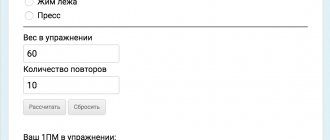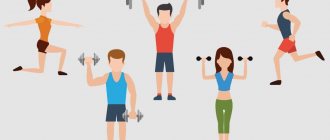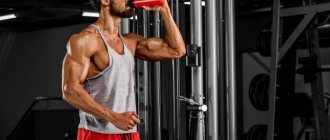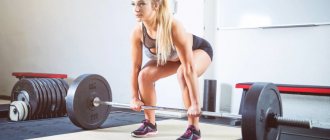TODAY SCIENCE HAS CAME TO OUR SPORT.[edit | edit code]
She proved that strength training is stressful. Despite the fact that it gives us bodybuilders real pleasure, the path to big muscles should be short. After all, the less stress in life, the better. So, today's bodybuilding bears little resemblance to its progenitor of the middle of the last century, when muscle mass was mined, as if in a coal face, by hard work and sweat. Nowadays, science has found many ways to cut corners. In other words, she enriched bodybuilding with unprecedented “fast” technologies. This did not make the road to the masses any easier. It’s just that from now on our sport requires not so much the perseverance of a rhinoceros, but rather the complex ability of the mind to comprehend new things, and then successfully implement them. We present to you an innovative way of training that guarantees rocket acceleration of muscle growth. Please note that such training has little in common with the bodybuilding of our grandfathers. Are you ready for radical changes?
Increased muscle mass
This is precisely the second case described in the definition. It is used primarily in bodybuilding. And you can do most exercises with it. Here's an example. You do 30kg barbell biceps curls for 10 reps. You do the tenth repetition with all your strength. And then slowly and under control lower the barbell down for 5 to 10 seconds. You can not limit yourself to one repetition, but ask your partner to lift the barbell up for you and do several more such repetitions.
The essence of the effect is that in this way you can put more stress on the muscles. And the stronger the stress, the better your muscles respond to the load. After all, it is such extreme stress that makes them grow.
In my practice, I widely use this method in pull-ups. When a person, after the last pull-up, goes down very slowly (up to 30 seconds). This approach allows you to increase the number of pull-ups.
Iron genius[edit | edit code]
Any strength exercise, be it a bench press or a deadlift, consists of two phases. First you lift the weight. and then lower it. The first phase is usually called positive, and the second - negative. Where did this terminology come from? Who thought of calling lifting a weight “good” and lowering it “bad”? The secret is simple. For a long time, it seemed to strength professionals that only the first phase, when you desperately fight gravity, increases muscle strength. Well, the second phase is forced: you just return the weight to the starting position for a new repetition. The weight of the projectile here acts together with the force of gravity, and therefore the phase itself is supposedly useless for the muscles. Following this logic, weightlifters completely abandoned the final stage of the clean and jerk. In both exercises, they lift the barbell with straight arms, and then bring it down to the floor along the shortest trajectory.
In bodybuilding, too, at first they ignored the negative phase and even called it “passive” in their own way (as opposed to the “active” phase of lifting weights). However, in the 70s, a unique person named Arthur Jones came to bodybuilding. The son of a provincial American doctor, he taught himself to read at the age of 5 and subsequently spoke 8 languages fluently. As a teenager, Arthur Jones fell in love with airplanes, and when World War II broke out, he tried to get a job as a civilian technician at a US bomber airfield. He was refused for two reasons. Firstly, Jones was only 15 years old, and secondly, he did not have a technical diploma. Jones insisted because he had worked in a car repair shop for a couple of years. Just for fun, he was allowed to take the exams, and he set a record of sorts, scoring the highest number of points in the history of admissions exams for civilian specialists. However, Arthur Jones was not the first to set records. After all, he grew up in a gangster area and trained with hardware from the age of 12.
Let's open the cards. Arthur Jones is the same inventor of the famous Nautilus exercise machines that launched the fitness club industry. All his life he remained an indefatigable experimenter and once, on a dare, he promised to make the unknown bodybuilder Casey Viator "Mr. America." Not only did Vaietor have a reputation as a complete outsider, but he was also dazzlingly young. Arthur Jones said that Casey would have superior muscle mass to mature athletes with decades of training behind them. To the amazement of skeptics, Vayetor actually won the prestigious tournament. On the podium, he showed unprecedented muscle volumes, but when they began to learn his secrets, it turned out that his trainer, Arthur Jones, had turned the exercises on its head. In preparation for the tournament, Vayator did not raise, but lowered the weight.
Many famous athletes were outraged, believing that Casey was simply fooling them. In response, Arthur Jones staged a demonstration experiment involving several particularly distrustful stars. Reluctantly, they performed only “negatives” for a month. At the end of the experiment, the athletes were in for a real shock. They all added 3 to 5 kg of lean muscle! Unfortunately, Jones's promising discovery was soon forgotten. Steroids came into bodybuilding and erased the search for something new for many years...
Exercises with negative repetitions
The lifting phase in bodybuilding is called the positive phase, and the lowering phase is called the negative phase. So, the technique of performing negatives depends on the specific strength exercise. Take, for example, an exercise for developing chest muscles - the bench press. In this case, everything is simple - your partner stands behind your head, grabs the barbell and helps you throw it onto the supports. Well, you can handle lowering the bar yourself.
It is curious that negatives consume less muscle quality such as strength endurance. And if you only have the stamina for 8-10 full barbell presses, then with the same weight you can easily overcome up to 15 negatives. So if you need to stay within the same number of repetitions, the weight of the barbell in the negatives should be increased by at least 10-12%.
A similar technique can be used when lifting a barbell for biceps. Your partner helps you throw it up to your collarbones. You lower the bar yourself.
The second discovery of America[edit | edit code]
Nowadays, science has rediscovered the meaning of negative repetitions. As you know, thin threads of muscle fibers tear ungodly at the moment of peak muscle tension. In this case, biological “garbage” is formed - scraps of organic tissue, fragments of molecules... The appearance of such “waste” in the blood serves as an alarm signal that forces the body to take countermeasures: mobilize stem cells, accelerate the synthesis of new protein and increase the secretion of anabolic hormones. Moreover, the more “slagged” your blood is after training, the more active the processes of recovery and muscle growth are.
When you lift a weight, the muscle tenses, objectively shortening its length. When you lower it, the muscle also has to contract, but at the same time it stretches. Stretching becomes an additional stress factor that practically doubles the number of muscle fiber breaks. This is precisely why muscles grow much faster from negatives than from lifting weights.
It turns out that negative repetitions need to replace the traditional training method? Unfortunately, lowering the weight is accompanied by a reflexive blocking of breathing, and therefore does not train the cardiovascular system at all. Well, without a resilient heart, there are no strength records. Remember how untrained beginners gasp when trying to finish a multi-rep set.
So, there is no way to give up the positive phase. Science suggests combining positives with negatives, but at the same time assigns only a subordinate role to positives.
What happens during the negative phase of the exercise?
The negative phase of the exercises must be done more slowly than the positive phase. Particular attention should be paid to ensuring that the target muscles for the exercise work during the phase. You need to practice the return movements so well and accurately that the body forms muscle memory. At first, you will have to strictly control the progress of the exercises mentally. Gradually, the correct functioning of the body during the negative phase will occur automatically.
You need to understand that a correctly constructed negative phase is no easier in terms of load than a positive one. You can imagine the entire exercise as the process of a spring, which slowly contracts and then shoots sharply. The ratio can be up to 5/2 in terms of time spent on both phases.
When the negative phase proceeds correctly, the target muscles are stretched and a significant load is placed on them. A microtear of the muscle fibers occurs, which means that the body’s forces are used to heal them, and accordingly, the muscles begin to increase in volume. However, muscle recovery after exercises focusing on the negative phase will take a longer time.
For experienced athletes, there is a technique for building training based on the complete exclusion of the positive phase of exercise while simultaneously using increased weight. In this case, it is necessary not only to have at least three partners insuring the athlete, but also to use special equipment. This type of training is extremely exhausting and difficult; it is not suitable for beginners and even advanced athletes.
Just go ahead! [edit | edit code]
So, here is an innovative training program based on negative repetitions. Such repetitions, according to science, require serious overload. The working weight is taken to be a load that is 30-50% higher than the one-time record achievement! But even this is not enough! In addition, you will lower the weight in a "unilateral" style. Let's say you're doing the Smith Bench Press. First, you press the barbell up with both hands, and then return it to the starting position with one hand. Then you again press the barbell with both hands and return it to the start with the other hand. All this is called one repetition.
This technique of performing negatives causes amazingly large-scale injuries to muscle fibers. A couple of repetitions are enough for recovery to last for a week! Following the negatives, 2-3 pumping sets should be done. This is a prerequisite for the method! The tandem of negatives with pumping brings dramatic acceleration of progress! From week to week, working weights, already critical, are steadily increasing. In the first week - 130%, in the second -140% and in the third - 150% of 1RM. It is absolutely forbidden to train for more than three weeks! Firstly, there is nowhere to increase the weight further, and secondly, your ligaments will need rest. Then you need to give up all training with hardware for exactly a week. It is clear that weights exceeding a one-time record cannot be overcome alone. Moreover, the set contains several repetitions. You will need the help and insurance of a dedicated partner.
The program is not at all similar to your previous workouts. But don't let this bother you! Bodybuilding also once began with a revolution: instead of one-time repetitions, the security forces began to do them in hundreds. Good luck!
What exercises should you do?
Doing negative reps only makes sense when performing basic exercises with free weights. So, in the bench press (how to do it correctly), this type of training helps to significantly increase performance and take on more working weight; for other options for increasing performance, see the material: How to increase the bench press. To perform it correctly, you must lift the barbell with the help of a partner and lower it yourself.
For biceps, you can do barbell or dumbbell curls, and pull-ups on a horizontal bar with additional weight will help develop the latissimus dorsi and deltoids. Don't forget about leg exercises like squats and deadlifts. When performing them, you also cannot do without an assistant who will lift the weight.
Attention![edit | edit code]
This training method is extremely difficult. It leads to extensive microtrauma of muscle tissue, and therefore cannot last longer than 3 weeks. This is followed by a week-long period of complete rest from training. Do no more than 2-3 repetitions per set. Since negative training is the most difficult of the currently known techniques, it can only be done three times a week. Otherwise, your nervous system risks not recovering. In this case, one muscle or muscle group can be loaded with negatives only once per weekly cycle.
• Preparation
. If you do not have a naturally strong and stocky build, and you do not have a solid training experience behind you, practice adaptation training for 3 weeks with a weight of 80% of your one-time maximum (1RM). This work will strengthen the ligamentous apparatus and protect you from injury.
• Warm-up
. Negatives extremely overload the ligaments and threaten injury. For this reason, each workout should be preceded by a deep warm-up. Do at least 10 minutes of light cardio and dynamic bodyweight exercises to warm up your joints. Next, before each “negative” exercise, do 2 sets in the usual style with a weight of 30% and 50% of 1RM. Next you need to do a “negative” one-sided set with a weight of 80% of 1RM. And only then can you proceed to the main negatives with an overhang of 130-150% of 1RM.
• Positive sets
. After the negatives, it is extremely important to “wash” the muscle with blood and at the same time “saturate” it with nutrients, hormones and oxygen. To do this, after the negatives, perform 2-3 additional sets of the same exercise in a pumping style (12-15 repetitions).
• Training frequency
. Train 3 times a week, loading a particular muscle only once per week.
• Calculation of working scales
. As a starting point, take the weight of the weight that you are able to overcome in the exercise only once (with the usual method of execution). In the first week, use weights equal to 130% of 1RM, in the second - 140% of 1RM, and in the third - 150% of 1RM.
About the negative phase
Regularly watching how bodybuilding enthusiasts train, I noticed that many people miss the most important element of the training process, which directly affects the growth of muscle mass. We are talking about the negative (eccentric) phase of the exercises.
Of course, few people neglect it completely, literally throwing the lifted weight (this occurs only in weightlifting). But few people lower the projectile under complete control. This usually resembles an attempt to slow down the acceleration developed by the projectile under the influence of gravity. In fact, the duration of the negative phase for a significant part of students only slightly exceeds the time spent on the positive phase. The difference is literally half a second. For example, 1 second rise - 1.5 seconds lower or 2 - 2.5. Moreover, the physiology is such that the muscle tension required for controlled lowering of the weight is much less than when lifting it. The weight that we are able to squeeze only once, we can easily lower under control three times. Well, if we allow the projectile to fall at high speed, then muscle tension at this moment is generally negligible.
However, in strength training aimed at developing hypertrophy, the eccentric and concentric phases of repetitions are equally important. This has been written about repeatedly in specialized bodybuilding magazines, and sports scientist and trainer Brad Schoenfeld recently provided further confirmation of this. He looked at 15 of the best-biased studies that required participants to do exclusively concentric or eccentric strength training. That is, all exercises were performed only in one phase in order to exclude their joint effect on hypertrophy. The obtained data were summarized and analyzed. As a result of concentric training alone, the average increase in muscle mass was 6.8%, and eccentric training alone - 10%. This means that, at a minimum, the eccentric phase is an important part of the rep when you want maximum muscle growth. By forcing the muscles to work fully in both phases, we will ensure a more complete impact of the load on those processes that lead to hypertrophy. That is, the hypertrophic response from the exercise performed will increase.
All you need to do is just start lowering the weight more slowly, focusing on it. You can quickly raise the weight, but not lower it. The slower the projectile descends, the more muscle effort is required and vice versa. Moreover, I advise you to try to apply the principle of wave periodization in planning the training process using the negative phase as one of the factors for varying the load.
Example (borrowed from Greg Nuckols):
1st week: start with 3 seconds in each repetition;
Week 2: 4 seconds;
Week 3: 5 seconds;
Week 4: increase the weight on the bar and return to the eccentric phase for 3 seconds, and then again.
Thus, by slowing down the time of lowering the apparatus, we increase the load from workout to workout without changing the weight of the weight. And only after finishing the three-week cycle, we add weight. Simple and effective!
If you are one of those who don’t pay much attention to the negative phase, then it’s time to change that
Attention. Materials posted in the section may be published in whole or in part only with the obligatory indication of the source of the publication.
Exercises[edit | edit code]
Negative repetitions - technique
SMITH BENCH PRESS[edit | edit code]
Take a lying position on a horizontal bench under the bar of a Smith machine. Grab the bar with a shoulder-width grip, as you would for a traditional bench press. With the help of a partner, remove the bar from the supports and jointly press the barbell upward. Under your partner's control, release one hand and slowly lower the weight to your chest with the other hand. Grasp the bar with both hands again and, with the help of an assistant, press the bar upward. Lower the bar by switching hands.
LYING LEG BEND[edit | edit code]
Take a lying position on the machine bench, face down, and place your feet under the movable rollers. With the help of a partner, lift the rollers up with both feet. Next, release one leg and, under the control of an assistant, lower the rollers with the other leg.
Raise the rollers up again with your partner. Repeat the reverse movement, changing your working leg.
CALK RAISES[edit | edit code]
Stand under the supports of the machine and support them with your shoulders. Place your toes on the foot step. Using the strength of both calf muscles, with the help of a partner, rise onto your toes as high as possible. Next, release one leg and slowly lower yourself to the bottom position on the other leg. Do the prescribed number of repetitions and change your working leg. Your partner must carefully control the reverse phase of the exercise so that the pace of the negative comes out slow and even.
PRESS DOWN[edit | edit code]
Grasp the D-handle with one hand. Place the hand of your other hand on top of the handle. Using the strength of both hands, with the help of a partner, lower the handle down. From the bottom position, “release” the handle with your working hand, controlling the movement with the other hand. Do the exercise the specified number of times and change hands. Even though negativity is relatively safe here, your partner needs to be on guard.
LEG PRESS[edit | edit code]
This exercise requires special attention from your partner. You will have to apply weight that is significantly greater than your working weight, and therefore the risk of injury is especially high. Be sure to use safety stops to prevent the platform from falling uncontrollably. Press the weight up with both legs with the help of a partner, but lower it with only one leg. After completing the specified number of repetitions, change your working leg.
SEATED ARM PULL[edit | edit code]
Attach a regular V-handle to the end of the pulley cable. Grab the handle and, with the help of your partner, pull it towards your stomach. Next, release one hand and “release” the handle with the other hand. Do the prescribed number of repetitions and change your working hand. If your hand is not strong enough to hold the handle, use a gymnastics strap. The partner must carefully control the reverse phase of the thrust so that the pace of the negative comes out emphatically even. No matter how difficult it is for you, do not tilt your body after your working hand.
RISES IN SMITH[edit | edit code]
Set the Smith machine bar at waist height. Stand facing the bar and grab it with both hands with an overhand grip, shoulder-width apart. With the help of a partner, remove the bar from the supports and lift it towards your shoulders. Next, release one hand and lower the bar to the starting position with the other hand. Do the prescribed number of repetitions and change your working hand. The lowering of the bar must occur under control and with the help of a partner.
WEIGHTED PULL-UPS[edit | edit code]
Put a power belt with a chain on your belt and hang the desired weight on the chain. Place a high support under the crossbar. Climb onto the support so that the bar is under your chin. Grab the bar and tense your arms. Step off the bar and slowly lower yourself with tense arms. Repeat the exercise. You can also do pull-ups yourself and then ask your partner to hand you a dumbbell. It should be squeezed between your feet. Next you need to lower yourself to the bottom position. DAY 1
Leg press
Negative sets 2x2 (one leg) Positive sets 3x12-15
Negatives:
Press with both legs, lower with your left leg;
rest 5-10 seconds. Press with both legs, lower with your right leg. Rest for 30 seconds and repeat the same sequence. All 4 negatives are considered one set. Rest as actively as you need (do not stand or sit). Repeat the set. Positives:
Do a regular double leg press at 70% of your 1RM. Rest 1 minute between sets.
Lying leg curls
Negative sets 2x2 (one leg) Positive sets 2x12-15
Negatives:
Bend both legs, lower the weight with your left leg;
rest 5-10 seconds. Bend both legs and lower the weight with your right leg. Rest for 30 seconds and repeat the same sequence. All 4 negatives are considered one set. Rest as actively as you need (do not stand or sit). Repeat the set. Positives:
Do regular double leg curls at 70% of your 1RM.
Rest 1 minute between sets. Finish with a cool-down with static stretching. Notes:
The complex seems short only on paper. Remember, it includes 3 more warm-up sets of each exercise. Due to the ultra-high load, both exercises force all leg muscles to work, both on the front and back surfaces.
DAY 2
Smith Press/Information
Negative sets 2x2 (one leg) Positive sets 3x12-15
Negatives:
Press with both hands, lower with your left hand;
rest 5-10 seconds. Press with both hands, lower with your right hand. Rest for 30 seconds and repeat the same sequence. All 4 negatives are considered one set. Positives:
Do exercises with both hands on the machine with a weight of 70% of 1 RM. Rest 1 minute between sets.
Press down
Negative sets 1x2 (one leg) Positive sets 3x12-15
Negatives:
Press with both hands, release with your left hand;
rest 5-10 seconds. Press with both hands and release with your right hand. Rest for 30 seconds and repeat the same sequence. All 4 negatives are considered one set. Positives:
Do a regular machine press with both arms at 70% of your 1RM. Rest 1 minute between sets.
Standing calf raises
Negative sets 2x2 (one leg) Positive sets 3x12-15
Negatives:
Rise on your toes with both feet, lower on your left foot;
rest 5-10 seconds. Rise on your toes with both feet and lower on your right foot. Rest for 30 seconds and repeat the same sequence. All 4 negatives are considered one set. Positives:
Do a regular two-leg calf raise at 70% of your 1RM.
Rest 1 minute between sets. Finish with a cool-down with static stretching. Notes:
Since leg presses already overload the calves, their targeted training has been moved to another day.
DAY 3
Seated arm row
Negative sets 2x2 (one leg) Positive sets 2x12-15
Negatives:
Pull the handle with both hands, release with your left hand;
rest 5-10 seconds. Pull the handle with both hands and release with your right hand. Rest for 30 seconds and repeat the same sequence. All 4 negatives are considered one set. Rest as actively as you need (do not stand or sit). Repeat the set. Positives:
Do a regular seated row with a weight of 70% of your 1RM. Rest 1 minute between sets.
Weighted Pull-Ups/Wide Overhead Rows
Negative sets 2x2 (one leg) Positive sets 2x12-15
Negatives:
Place a high support under the crossbar.
And attach a weight to your belt or hold a dumbbell between your feet. Step off the support and slowly lower yourself to the bottom position. Rest for 5-10 seconds. Do 2 reps for each of 2 sets. Rest as actively as you need (do not stand or sit). Positives:
Do wide, seated overhead rows at 70% of your 1RM. Rest 1 minute between sets.
Smith Get-Ups/Barbell Get-Ups
Negative sets 2x2 (one leg) Positive sets 2x12-15
Negatives:
Raise the bar with both hands, lower it with your left hand;
rest 5-10 seconds. Raise the bar with both hands and lower it with your right hand. Rest for 30 seconds and repeat the same sequence. All 4 negatives are considered one set. Rest as actively as you need (do not stand or sit). Repeat the set. Positives:
Do regular standing barbell raises at 70% of your 1RM.
Rest 1 minute between sets. Notes:
Despite the small number of exercises, the workout extremely activates the back muscles and biceps. Because the biceps are stressed when performing back exercises, biceps curls may not be performed in the second week. Indisputable proof of the effectiveness of the program is the severe post-workout muscle pain. It must be distinguished from joint pain, which may indicate injury.
Source Muscle and Fitness #4
What are negative and positive phases of training?
Moscow 24 columnist, fitness expert and TV presenter Eduard Kanevsky explains what operating modes exist when exercising in the gym and why they are so important.
Photo: depositphotos/lunamarina
When I studied at a pedagogical university, there was one subject because of which I was almost expelled from the fifth year. The teacher of this discipline was so principled that after two attempts to pass the exam with him, I had to retake it at the state commission. And, despite the fact that my faculty was biology and ecology, and my specialty was biology (which, by the way, I always knew and studied very well), they wanted to expel me for “ignorance of biology teaching methods.” It would seem, well, it can’t be! But no, maybe. True, such a principled position of the teacher was completely justified, because the university is pedagogical.
Indeed, the methodology of teaching, production or training is the key to high-quality learning of the material, the finished product or the result of your classes. And neglecting the technique, especially when it comes to training, also means you risk getting injured. It is especially important to follow methodological recommendations and operating modes when exercising in the gym as in a high-risk area. And in this article I will talk in detail about the “positive” and “negative” in exercises.
What is it? – a completely natural question arises. Is it when you get angry while lifting weights? And is there then positive repetition? The first statement, of course, is absolutely not true, although anger really helps to work with weights and give your best in competitions. But negative repetitions have nothing to do with anger at all. But as for the reasoning about positive repetition, here the logic works correctly - such repetitions really exist. Let's figure out what kind of play on words this is.
Photo: depositphotos/ibrak
If you have never been involved in the gym or sports in general, then if you are asked to do some exercise with a barbell without first showing you the technique, then most likely you will just start lifting it up and down quite quickly. In essence, you will do as you did, for example, in school in physical education lessons, where the main thing is not so much the quality of performing a particular movement, but rather the number of repetitions. It is logical that during training in the gym, the main goal of which is high-quality work on a particular muscle or muscle group, this mode of work will not give the desired result. And for two reasons:
- firstly (and this is important to understand), a muscle is a “contractile element”, and it must itself do the work it needs without additional, inertial movement (in other words, sudden movements, swinging, “throwing” weights significantly reduce the load on muscle fibers );
- secondly, the risk of injury increases significantly, because weights, if used incorrectly, can seriously injure a muscle or tendon precisely because of the uncontrolled pace of work.
And that is not all.
It is known that muscles consist of two types of fibers: fast and slow. As a rule, the ratio of one to the other is approximately the same for most people, but if you are not involved in professional sports, where there is a concept of specialization, it is important to work on both fibers. This will give the best results both in gaining muscle mass and in increasing strength indicators. This is where those very negative and positive phases of the movement come to the rescue.
Negative reps are also called “yielding” muscle contractions. This is when you lie under a barbell, the weight of which inevitably forces you to bend your arms, lowering the weight towards your chest. This very resistance to weight is called the negative phase of the exercise. Moreover, this phase is perhaps the most important, because if you suddenly lower the weight, as I said earlier, then you risk serious injury, especially when working with heavy weights, where maximum controlled work is important. Moreover, the negative phase as a whole maximally involves muscle fibers, which inevitably affects the result.
Photo: depositphotos/VitalikRadko
After completing the negative phase, it is important for you to return the bar to its original position, that is, if we are talking about the bench press exercise, straighten your arms. And this phase, which is also called “overcoming contraction,” is called positive. Thanks to it, you focus on fast muscle fibers. In addition, by lifting the weight faster than you lowered it, you don’t get tired as quickly, which means you can perform more repetitions, which allows you to work your muscles better and you won’t be “crushed” by the weight.
Yes, there are faster or slower modes of work, but these are different methodological techniques that more experienced practitioners use in practice.
By the way, in all movements where the weight presses down, the negative phase will be directed downward. But there are exercises where such a phase will not be “towards oneself”, but “from oneself” - these are all types of traction exercises. As a rule, these are all exercises for developing the back muscles - for example, pulling the upper block to the chest or, to make it clear for complete beginners, an analogue of this movement - pull-ups on the bar. Here the positive movement is pulling up. But lowering down is a negative phase, which is performed slowly.
Kanevsky Eduard
Voltage is different
Answer a seemingly simple question: when do the leg muscles get more load - when going uphill or when going down? It would seem that there is nothing to think about here, it is clear that during the ascent! But no! Your muscles work much more actively when descending a mountain. The same thing happens when doing strength exercises.
The muscle itself is created by nature to overcome weight by reducing its length. Its stretching is usually associated with rest and relaxation, but here there is a critical force load! Here everything in the muscle is activated - from biochemical reactions to the last muscle fiber. According to competent scientific research, the force applied when lowering a weight is at least one and a half times greater than the dynamic force (when lifting it)! This is where the quick results come from!
If you're still confused about the supposed paradox, here's a scientific explanation. Remember, when you lift weights, what is the muscle? Right! It contracts, that is, it reduces its length. What if you lower it? The muscle is stretched. But! At the same time, she experiences the same effect of weight. In fact, the bar didn't get any lighter. So, forceful stretching is much more difficult for a muscle.











